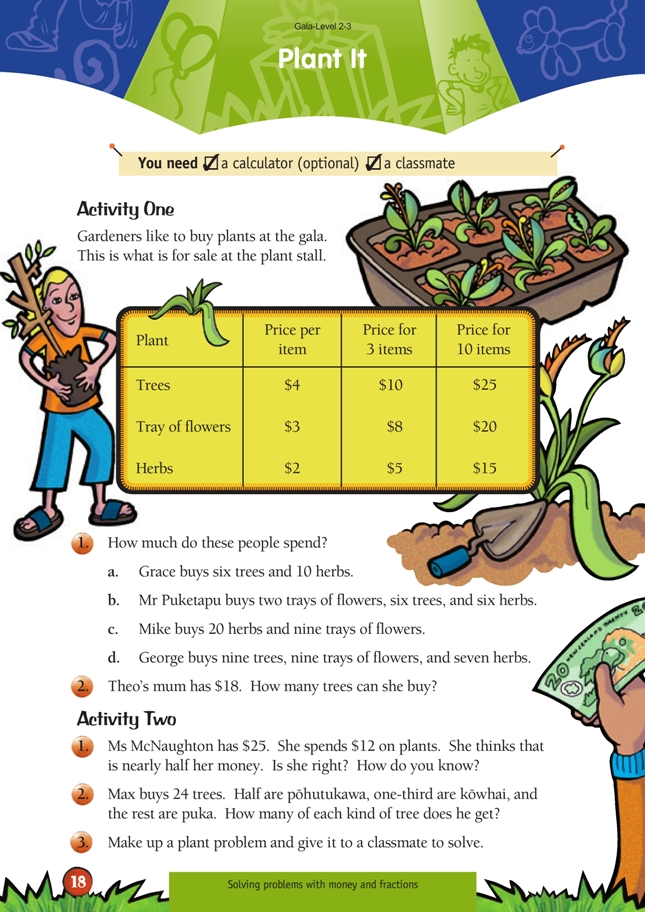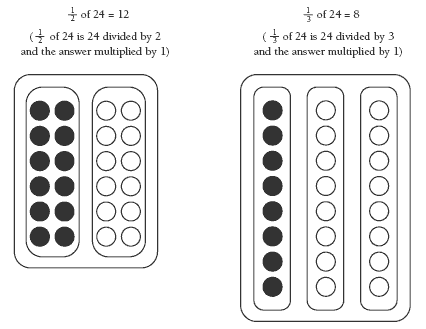This is a level 3 number activity from the Figure It Out theme series.
A PDF of the student activity is included.
Click on the image to enlarge it. Click again to close. Download PDF (286 KB)
use multiplication facts to solve problems
find fractions of whole numbers
FIO, Level 2-3, Theme: Gala, Plant it, page 18
A classmate
Activity One
This activity will give students further experience in breaking down calculations into key steps. They are likely to attempt the problem in various ways, such as written equations, using a table, mental calculation, or using a calculator memory function.
Talk through the table with the students and make sure they understand how to choose the appropriate pricing category. For example:
• “If you bought six trays of flowers, how much would you pay?” ($8 x 2)
• “How do you combine the cost of two types of plant?”
The students could use a table, such as the one below, to help itemise purchases and to avoid having wrong answers caused by the incorrect order of operations, which can happen if they use a basic calculator.
Encourage the students to develop their own table format to share with the class.
Using the calculator memory on a basic calculator avoids this incorrect order of operations.
This type of question is excellent for giving the students experience in using a calculator memory to efficiently solve problems. For example, for question 1b, they would key in:
Encourage the students to mentally estimate the answer as well as using a calculator so they can be alerted if their answer is not sensible.
Activity Two
In this activity, the students are dealing with fractions. Finding half of an odd number, as in question 1, is not as straightforward as finding half an even number. There are several ways you could help students answer question 1:
• Ask them what half of 24 is and how they worked that out. “What about half of 26? What about half of 25?”
• Begin with a similar question with lower numbers. For example, “Malcolm kicked seven goals out of 11. Was he successful with more than half or fewer than half of his attempts? How do you know?”
• Model the question with toy money. You could start with denominations such as two $10 notes, two $2 coins, and two 50 cent pieces and then try other denominations that don’t divide into halves so easily.
• Create a model, such as a fraction chart, and ask the students where halfway is.
As an extension, the students might like to investigate the relationship between 101/201and a half.
Some students may like to model question 2 with materials such as counters, beans, or their classmates. For example, “If there are 24 beans (or children), how do you find a half? How do you find a third? How many are left?”
Some students may also need to use concrete materials to write new problems for question 3.
Some students may have noticed the relationship between equal subsets (that is, fractions) and division and will therefore be able to use their knowledge of division to calculate the answer. You will need to use your own judgment as to which approach will be best for your students.
Answers to Activities
Activity One
1. a. ($10 x 2) + $15 = $35
b. ($3 x 2) + ($10 x 2) + ($5 x 2) = $36
c. ($15 x 2) + ($8 x 3) = $54
d. ($10 x 3) + ($8 x 3) + ($5 x 2) + $2 = $66
2. 5
Activity Two
1. Yes, because 2 x 12 = 24, so 12 is just under half of 25.
2. 12 pōhutukawa: 1/2 of 24 = 24 ÷ 2 or 24 x 1/2
8 kōwhai: 1/3 of 24 = 24 ÷ 3 or 24 x 1/3
4 puka: 24 – (12 + 8)
3. Answers will vary.




